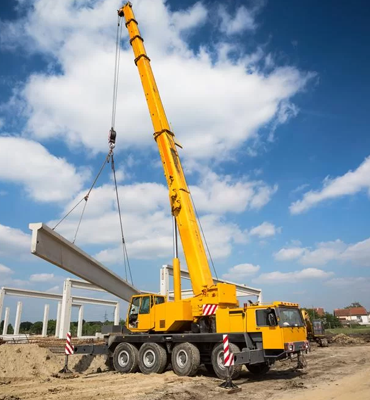Cranes Telescopic Crane
A telescopic crane, also known as a telescoping crane or a mobile telescopic crane, is a type of mobile crane that uses a telescopic boom or arm to extend and retract its length. This design allows the crane to adjust its boom length according to the specific lifting requirements of different tasks. Telescopic cranes are widely used in various construction, industrial, and infrastructure projects due to their flexibility, mobility, and efficiency.
Key features and characteristics of telescopic cranes include:
-
Telescopic Boom:
The primary feature of a telescopic crane is its telescopic boom, which consists of multiple nested sections that can extend or retract to varying lengths. These sections slide into one another, much like a telescope, giving the crane its name.
-
Hydraulic System:
Telescopic cranes use hydraulic systems to extend and retract the boom sections smoothly. Hydraulic cylinders and pistons power the movement of the boom, allowing for precise and controlled adjustments.
-
Lifting Capacity:
Telescopic cranes come in various sizes and lifting capacities, ranging from small mobile cranes used for light-duty tasks to large telescopic cranes capable of lifting heavy loads.
-
Mobility :
Telescopic cranes are mounted on wheeled chassis, making them highly mobile and allowing them to travel on roads and access different work sites.
-
Quick Setup:
Telescopic cranes are known for their relatively quick setup times compared to other types of cranes, making them suitable for projects that require frequent movement between locations.
-
Versatility:
The telescopic boom can be extended to reach greater heights or retracted to reduce the overall length of the crane when not in use. This versatility makes telescopic cranes suitable for a wide range of lifting tasks.
-
Outriggers/Stabilizers:
Many telescopic cranes are equipped with outriggers or stabilizers that extend from the chassis to provide additional stability during lifting operations.
-
Control System:
Telescopic cranes are operated by skilled crane operators using a control system that manages the extension, retraction, and movement of the boom and other crane functions.
-
Applications:
Telescopic cranes are commonly used in construction sites, building maintenance, infrastructure projects, material handling at ports, and various industrial applications.
-
Safety:
Safety is a critical aspect of operating telescopic cranes, and operators must follow strict safety guidelines and best practices to ensure accident-free operations.
Telescopic cranes offer a practical solution for many lifting needs due to their adaptability, mobility, and efficient setup. Their ability to extend and retract the boom allows for precise and controlled lifting, making them popular choices for a wide range of construction and lifting tasks.


